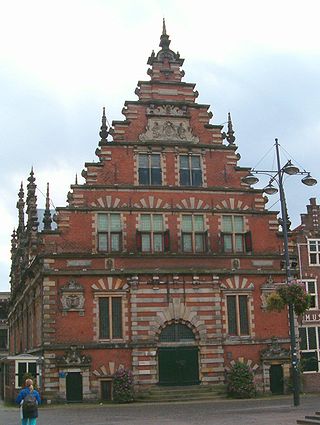
Lieven de Key was a Flemish renaissance architect who after working in his native Flanders moved to work in the Dutch Republic. He is mostly known today for his works in Haarlem. His style is described by Simon Schama as Mannerist.

A guildhall, also known as a "guild hall" or "guild house," is a historical building originally used for tax collecting by municipalities or merchants in Europe, with many surviving today in Great Britain and the Low Countries. These buildings commonly become town halls and in some cases museums while retaining their original names.
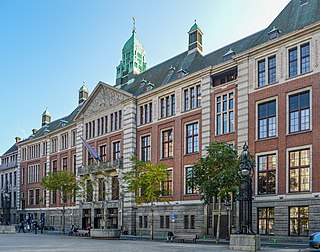
Euronext Amsterdam is a stock exchange based in Amsterdam, the Netherlands. Formerly known as the Amsterdam Stock Exchange, it merged on 22 September 2000 with the Brussels Stock Exchange and the Paris Stock Exchange to form Euronext. The registered office of Euronext, itself incorporated in the Netherlands a public limited company, is also located in the exchange.
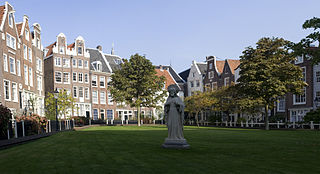
The Begijnhof is one of the oldest hofjes in Amsterdam, Netherlands. A group of historic buildings, mostly private dwellings, centre on it. As the name suggests, it was originally a béguinage. Today it is also the site of two churches, the Catholic Houten Huys and the English Reformed Church.

The Amsterdam Museum, known until 2010 as the Amsterdam Historical Museum, is an Amsterdam-based museum dedicated to the city's past and present. Due to the renovation of its main location, the museum is temporarily located in the building the Amstelhof on the Amstel River, together with H'ART Museum and the dependence of the Museum van de Geest.

Hendrik Gerritsz Pot was a Dutch Golden Age painter, who lived and painted in Haarlem, where he was an officer of the militia, or schutterij. Dutch artist Frans Hals painted Pot in militia sash in Hals' The Officers of the St Adrian Militia Company in 1633. Pot is the man reading a book on the far right.

Abraham de Vries was a Dutch painter who was one of the leading portraitists of his age. As he led a peripatetic lifestyle and worked in France, Antwerp and the Dutch Republic his stylistic qualities are difficult to pin down.

Hotel Die Port van Cleve is a historical 4-star hotel on the Nieuwezijds Voorburgwal in Amsterdam. The hotel is situated in the centre of Amsterdam, immediately north of the Magna Plaza shopping centre, and west of the Royal Palace on the Dam Square.

Beeckestijn is a historical buitenplaats dating from the 18th century in a park by the same name in Velsen-Zuid, Netherlands.
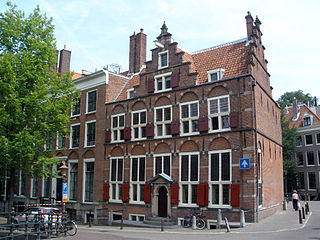
The Huis aan de Drie Grachten or Huis op de Drie Grachten is a 17th-century canal house in Amsterdam, at the southeastern end of the Wallen district. The name is a reference to the fact that the building faces three different Amsterdam canals. The south facade faces Grimburgwal, the west facade faces Oudezijds Voorburgwal and the east facade faces Oudezijds Achterburgwal. The address is Oudezijds Voorburgwal 249.

The Korenbeurs was a 17th-century commodity market in Amsterdam where grain was traded. The building stood on the banks of the Amstel, on the western side (Nieuwezijde) of the Damrak. It was directly south of the Oude Brug bridge, on a spot now occupied by the former stock and commodity exchange Beurs van Berlage.

The Wijnkopersgildehuis is a former guildhall in Amsterdam. The 17th-century double house is located at Koestraat 10–12, near Nieuwmarkt square. It is one of the few remaining guildhalls in Amsterdam and has the oldest known neck-gables. The building has rijksmonument status.

The Waag is a 15th-century building on Nieuwmarkt square in Amsterdam. It was originally a city gate and part of the walls of Amsterdam. Later it served as a guildhall, museum, fire station and anatomical theatre, among other things.
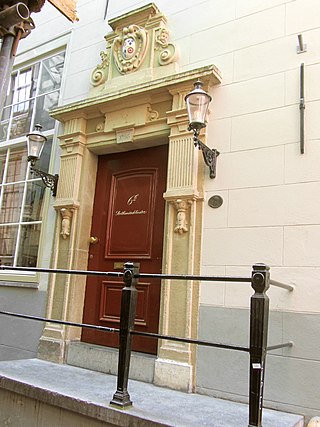
The Bethaniënklooster is a former 15th-century monastery in the Wallen area of Amsterdam. It is one of the few remains of the once-expansive area of monasteries that dominated the oudezijde of town in the Middle Ages. The monastery was devoted to Mary of Bethany and, at its largest extent, encompassed the entire area between Bloedstraat and Oude Hoogstraat streets to the north and south and Oudezijds Achterburgwal and Kloveniersburgwal canals to the west and east.

The Walloon Church is a Protestant church building in Amsterdam, along the southern stretch of the Oudezijds Achterburgwal canal. The building dates to the late 15th century and has been in use as a Walloon church since 1586. The church was also known as the Franse Kerk, Walenkerk, Oude Walenkerk, or Oude Waalse Kerk.

The House with the Heads is a large canal house on the Keizersgracht 123 in Amsterdam, named after the six ornaments shaped as heads, which are on the façade. The house is a rijksmonument and is listed on the Top 100 Dutch heritage sites.
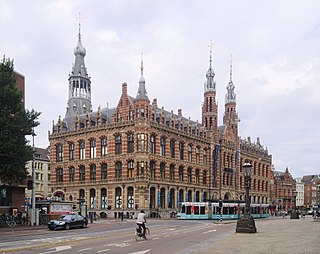
The former Amsterdam Main Post Office, now the Magna Plaza shopping centre, is a monumental building located at Nieuwezijds Voorburgwal 182 in Amsterdam, Netherlands. It was built in 1895–1899 in neo-Gothic and neo-Renaissance style. The building has been a rijksmonument since 9 July 1974, and is part of the Top 100 Dutch heritage sites.

The Oudezijds Voorburgwal, often abbreviated to OZ Voorburgwal, is a street and canal in De Wallen in the center of Amsterdam. It runs from the Grimburgwal in the south to the Zeedijk in the north, where it changes into the Oudezijds Kolk, which drains into the IJ.

The Blauwburgwal is a canal in Amsterdam between the Singel and the Herengracht. It is close to the city center and part of the west Grachtengordel.

The Spuistraat in downtown Amsterdam connects the Hekelveld to the Spui. It runs roughly north to south, parallel to the Singel and the Nieuwezijds Voorburgwal. At the Royal Palace of Amsterdam, the Spuistraat crosses the Raadhuisstraat and Paleisstraat. Originally the Spuistraat was a canal, the Nieuwezijds Achterburgwal. The canal was filled up in 1867, and the street was then renamed.























